
|
|
|
|
|
|
2016
Completion of the Panama Canal expansion project
Built from 1881 until 1914, the Panama Canal was among the largest and most difficult engineering projects ever undertaken. Functioning as a short cut between the Atlantic and Pacific Oceans, it greatly reduced the travel times for ships – enabling them to avoid the lengthy, hazardous Cape Horn route around the southernmost tip of South America.
For nearly a hundred years, the canal enjoyed great success, acting as a key conduit for international maritime trade. By the early 21st century, however, it was handling far more vessel traffic than had ever been envisioned by its builders. In 1934, it was estimated that the maximum capacity of the canal would be around 80 million tons per year. In 2010, the actual figure was nearly 300 million tons and growing rapidly, with over a third of shipping traffic unable to pass through because of size. Global demand necessitated a major upgrade.
Plans were formulated for various improvements – including the excavation of new traffic lanes allowing more and larger ships to transit; two new locks, one each on the Atlantic and Pacific sides; the widening and deepening of existing channels; and the raising of Gatun Lake's maximum operating level. Construction was originally slated to take seven or eight years, with new locks beginning operations in late 2014, almost exactly a century after the canal first opened. In 2012, however, it was announced that the expansion project had fallen six months behind schedule, pushing the opening date back to April 2015. Further delays were reported in September 2014.
In early 2016, construction is finally completed and the new gates are open for transit.* Capacity has now been doubled, allowing the canal as a whole to handle the projected rise in volume to 2025 and beyond. This mega-project eases numerous burdens on the shipping industry, as well as creating huge numbers of jobs among the Panamanian people – generating enough wealth to reduce poverty in the country by almost 30%. However, critics of the project contend that there are serious environmental issues.
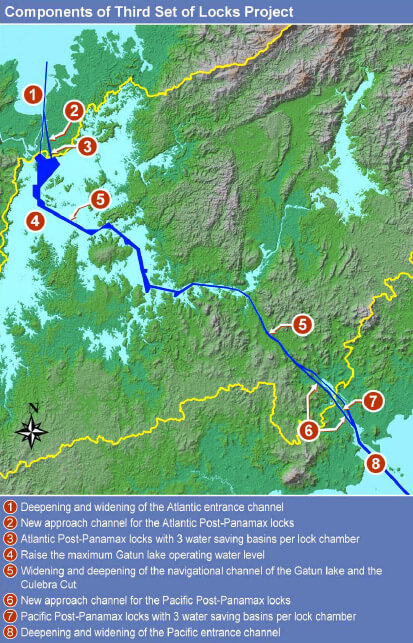
Map of Panama Canal expansion project in 2016. Credit: PanCanal.com
Microchipping of all dogs in England
In April 2016, a new law comes into effect requiring all dogs in England to be tagged with a microchip implant.* This measure has been introduced in order to cut the growing number of strays. As of 2012, there were 118,932 dogs reported lost or stolen, of which 55,898 (about 47%) were reunited with their owner. Around 6,900 (5%) were put to sleep. This cost £57m (US$89m) to the taxpayer and welfare charities each year. Only 7,098 dogs were microchipped in 2012, barely 0.1% of the 6.7 million dogs in England.
These implants are similar in size to a grain of rice. They are coated in a bio-compatible glass, the same material used in human pacemakers, ensuring they are not rejected. The devices are held firmly in place by fusing to the dog's bodily tissue. A simple procedure can be performed without anaesthetic, using a sterile needle to insert the chip between the shoulder blades.
Similar measures had already been introduced in New Zealand and Northern Ireland. Other countries begin to recognise the benefits of microchipping in the years ahead. By the 2040s, this is being extended into humans.*
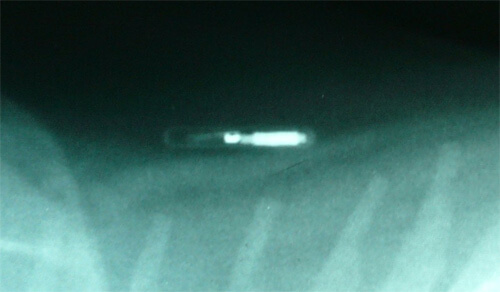
X-ray view of a microchip implant. Credit: Joelmills/Hundehalter
Euro 2016 is held in France
The 2016 European Football Championship is hosted by France between 10th June–10th July 2016. This year, the tournament is expanded in size from 16 to 24 teams, following a plan unanimously agreed by senior officials of all 53 UEFA member nations. The format of the final tournament consists of six groups of four teams, followed by a round of 16, quarter-finals, semi-finals and final. The top two from each group will qualify in addition to the four best third-ranked sides, the same system as was applied in the World Cups from 1986 to 1994. This format generates a total of 51 games, compared with 31 prior to 2016, played over a period of 29 days.

Rio de Janeiro hosts the Olympic Games
Rio becomes the first South American city to host the event, which opens on 5th August 2016 and finishes on 21st August 2016.

Supercomputers reach 100 petaflops
In 2013, China's Tianhe-2 became the fastest supercomputer in the world, achieving 33.8 petaflops, with a peak performance of 54.9 petaflops. It was nearly twice as powerful as its nearest competitor, the "Titan" machine at Oak Ridge National Laboratory in Tennessee, United States. Tianhe-2 showed great success in computational fluid dynamics (CFD), scramjet combustion and other aircraft simulations. Other research areas included genomics (population genetics) and biomedical applications. It continued to maintain the top spot for the next few years, with no other challengers, leading to concerns over a possible stagnation in the progress of supercomputing speeds. This was further compounded by trade restrictions – imposed by the United States government – which prevented China from using Intel's chip technology for upgrades. However, this actually boosted China's own processor development and production industry.
In 2016, China unveiled the "Sunway TaihuLight", a home-grown machine with a Linpack rating of 93 petaflops, a peak performance of 125 petaflops and featuring 10.6 million CPU cores. This became the first supercomputer to demonstrate a peak performance of over 100 petaflops, or 100 quadrillion floating point operations per second.*
This machine would reign at the top of the list for only a short while, however, as the U.S. was regaining its lead in supercomputing research. A project called "Aurora" was being developed at the Argonne Leadership Computing Facility (180 petaflops), along with IBM's "Summit" (150 petaflops), the latter having an optional upgrade to 300 petaflops. This would be followed by the first exascale computer (1,000 petaflops) by 2022.

Tianhe-2. Credit: O01326 (Own work) [CC BY-SA 4.0], via Wikimedia Commons
The Juno probe arrives at Jupiter
Launched in 2011, Juno becomes the second probe to orbit the gas giant, the first being Galileo in 1995. It is equipped with a camera, infrared and microwave radiometers, particle detectors, and an ultraviolet spectrometer. The mission objectives are:
• Determine precisely how much water is in Jupiter's atmosphere, to help confirm which planet formation theory is correct (or if new theories are needed).
• Look deep into Jupiter's atmosphere to gain a better understanding of its composition, cloud motions, temperature and other properties.
• Map Jupiter's magnetic and gravity fields – revealing its deep structure, core mass and overall dynamics, helping to further explain the planet's origin.
• Explore and study Jupiter's magnetosphere near the poles, especially the auroras – Jupiter's northern and southern lights – providing new insights into how the planet's enormous magnetic field affects its atmosphere.
Juno arrives at the planet in July 2016 and its mission concludes in October 2017, after a total of 33 orbits.* Like its predecessor, Galileo, it is crashed into the outer atmosphere of the gas giant, where it compresses and then melts as it falls.
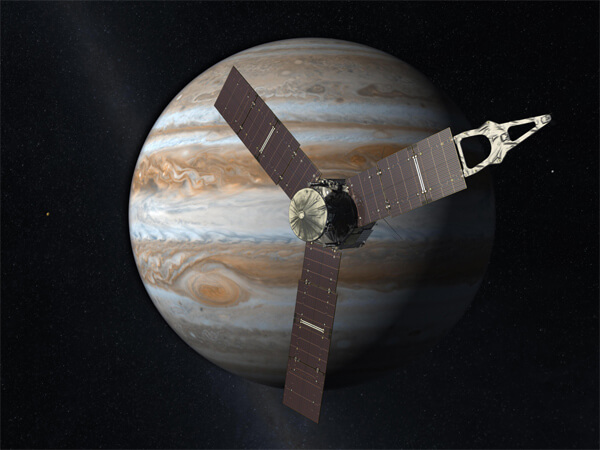
Credit: NASA/JPL
The world's largest single-aperture telescope is completed in China
The Five-hundred-metre Aperture Spherical radio Telescope (FAST) is a major new astronomical observatory built in Guizhou province, southwest China. Constructed between March 2011 and September 2016,* it becomes the largest single-aperture telescope in the world, half a kilometre wide and featuring a collecting area of 2.1 million sq ft (196,000 sq m). This dwarfs the next largest – the Arecibo Observatory in Puerto Rico – which had held the title since 1963.* The dish itself sits within a natural depression and is unable to move, due to its enormous size. However, the surface shape is changeable and the feed cabin (where radio waves are focused) can be moved around. This provides a viewing angle of up to 40° from the vertical.
FAST is able to gaze three times further into space and survey the skies ten times faster than Arecibo. Its primary roles include mapping the neutral hydrogen within the Milky Way at very high resolution, tripling the number of known pulsars from 2,000 to 6,000, and listening for possible signals from alien civilisations at distances of up to 1,000 light years; far more stars can be monitored than in previous surveys. FAST is the latest in a whole series of massive new telescopes being built around the world in the early 21st century, heralding a new era of astronomy.
Click to enlarge
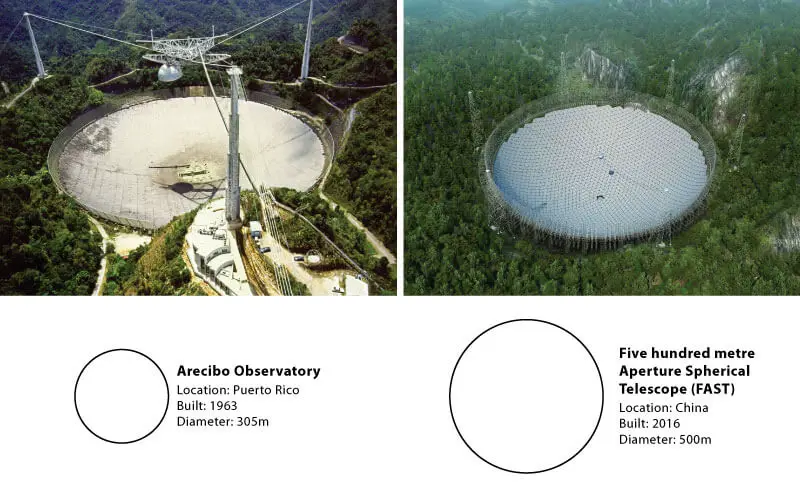
Credit: NASA / National Development and Reform Commission (NDRC) and the Chinese Academy of Sciences (CAS)
The mining industry is highly automated
Recent years have seen a rapid increase in the use of automation, a trend that is becoming especially prevalent in the mining sector. Rio Tinto, for example, now has a fleet of self-driving haul trucks which together are responsible for over half of its total material moved.** Codelco, meanwhile, has installed automated IT systems which now cover both its open pit mines along with all underground operations.* Wireless, intelligent devices are able to communicate with each other to monitor environmental conditions and to automate control of the mines' technological systems and equipment.
Self-driving vehicles, robotic drills, remote ship loading and other systems – despite their greater efficiency and improved safety – are now having a major impact on employment and economic activity. This is particularly true of Indigenous Australians in remote communities, for whom the mining industry has been their biggest employer. Some companies have promoted Aboriginal training, scholarships and business development, to provide the skills needed for new hi-tech jobs created by automation. However, the bulk of entry-level jobs are disappearing.*
As the use of robots and tele-operated machinery continues to increase, mining has begun to expand into new environments and locations that were previously off-limits to humans. This includes the seafloor, rich in metals like gold, copper, manganese, nickel and cobalt.** Longer term plans are being made to exploit asteroids.*
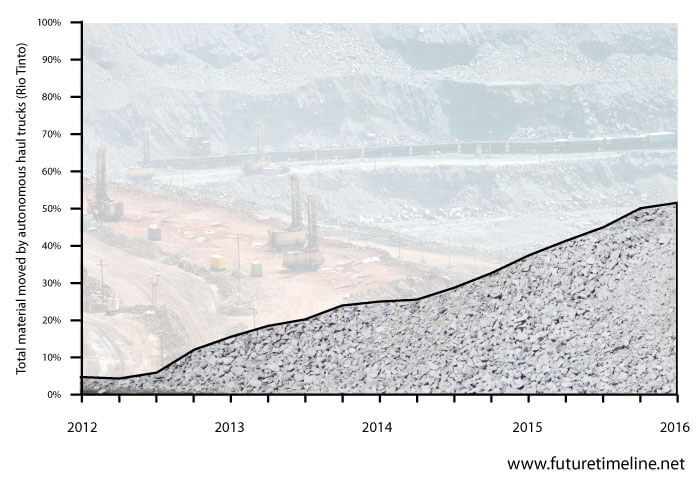
Agricultural robots are increasingly common on farms
Significant numbers of robots are now appearing on farms.* These have been in development for 20 years and are now cheap and sophisticated enough for mainstream use. New scanning and imaging technology has solved the problem of allowing robots to handle the varying shapes of individual fruits and vegetables. Their on-board computers can now differentiate between an object and its shadow and between green fruits, leaves and vines. This is accomplished using an array of cameras, each picking up a different spectrum of light and creating a perfect picture of the obstacles and topography in the robot's surrounding environment.*
Complex algorithms allow robotic workers to "learn" the longer they are on the job, so they become more adept as time goes on. This helps the computer to recognise a fruit that is partially covered by a leaf or similar obstruction, for example. The grasping tools themselves are based on human movements and are programmed to apply the correct pressure.
Advantages of this technology include much greater accuracy in spraying pesticides (cutting its use by 80%), uninterrupted output, and, as the technology improves, greater efficiency and speed. Initially, these robots are present on a small number of farms, often working alongside traditional human workers. As the years go by, however, and the technology proliferates, more and more farms begin to adopt robotic workers. By the end of this decade, entire farms are becoming fully automated.*
The increased output helps to alleviate food shortages caused by rising global populations. Despite these gains, agricultural robots prove controversial. They exacerbate the ongoing unemployment crisis, with the potential of putting many thousands of workers out of a job. Mechanisation continues its unending progress, as yet another industry begins to be handed over to machines.
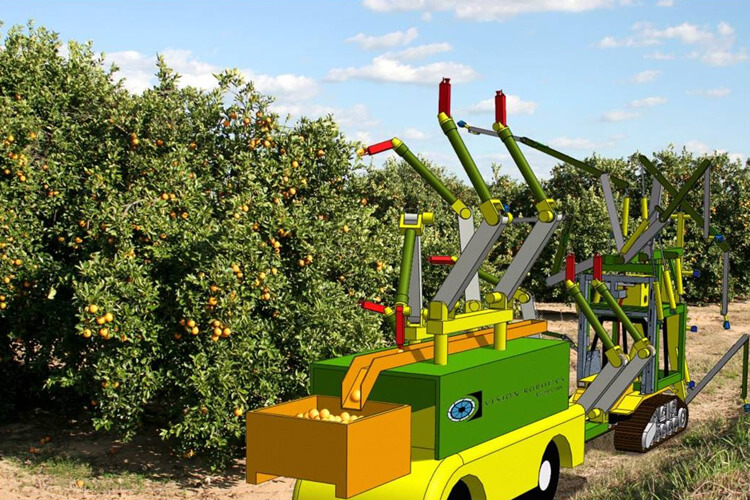
Credit: Vision Robotics Corporation
High-definition CCTV cameras are ubiquitous
Closed-circuit television (CCTV) has improved hugely in recent years with a shift from analogue to digital equipment. The vast majority of cameras now record footage in high definition, with some capable of gigapixel resolution. Although discouraging crime and helping to identify more offenders (made easier with facial recognition software), this mass proliferation of security is raising a number of privacy and civil liberties issues, due to a creeping sense of "Big Brother". For instance, governments are using them to keep tabs on people to stifle protest, free expression and assembly.* This is especially notable in the UK – a country renowned for its surveillance culture – with more CCTV cameras per capita than anywhere else on the planet, and where the average person is filmed over 300 times each day. In 2012, there were 1.85 million CCTV cameras in the UK, 129,000 of which were high definition. By 2016, there are 3.7 million HD cameras, a 29-fold increase.*
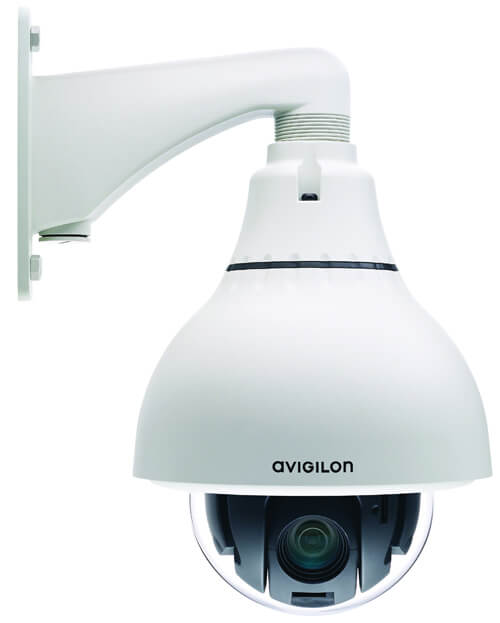
OLED displays are in widespread use
Having fallen greatly in cost, organic light-emitting diodes (OLED) are now available in a wide range of devices. These use less power than traditional LCDs whilst allowing sharper, thinner, brighter displays. They also eliminate the need for back lights. Sunlight that would normally "wash out" a display has no effect – the screens appear the same even in broad daylight, or when tilted at an angle.**
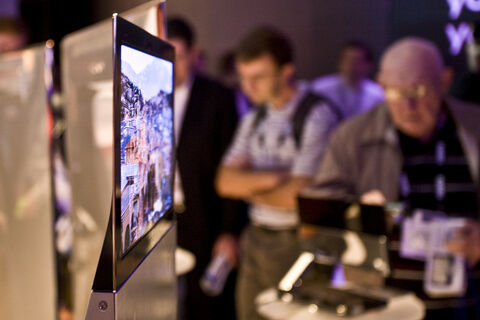
Three-person babies
A new method of IVF which involves the creation of babies with three parents has been introduced in the UK.* The controversial technique uses DNA from parents and combines it with healthy mitochondria from a female donor. This can prevent a rare, potentially fatal disease occurring that would normally cause a severe lack of energy, muscle weakness and in some cases heart failure. Although the baby has genetic material from three people, regulations state that for legal purposes it has two and the donor remains anonymous. A number of ethical concerns are raised by this landmark in IVF, but the treatment is shown to be safe. More advanced techniques will emerge in the decades ahead, leading to "designer babies" for the wealthy.*

China completes the largest environmental cleanup in its history
The rapid growth of China in recent decades led to some truly appalling environmental conditions in the country, particularly the developing urban areas. Since 2006, China had been the world's largest producer of CO2, a result of coal power supplying 70% of the country's energy. Smog became a major problem in cities, with lung disease affecting many millions of their inhabitants. By 2011, 16 of the world's 20 most polluted cities were located in China, with Linfen, Shanxi Province the most polluted overall.* Numerous rivers and aquifers were endangered.*
To rectify these conditions, the Chinese government in 2011 began an ambitious Five Year Plan to stem the flow of pollutants and clean up the damage done.* A tax was applied to heavy polluters, based on the output of hazardous chemicals and sewage. The goal was to fix the situation caused by the previously unregulated industrial growth, which had first attracted the polluters to the country. The resultant revenue primarily went towards restoring damaged environments. Many non-profit groups aided in the cleanup during this time. New regulations were also introduced, putting a cap on energy use. Targets were set to lower carbon emissions significantly. This went along with China's long term goal of green energy dominance.
Though some progress has been made over this five year period, the entrenchment of dirty industry and the explosive growth of the country makes it very difficult to turn the environmental situation around. It will take decades of further work before China has transitioned to a truly green economy.
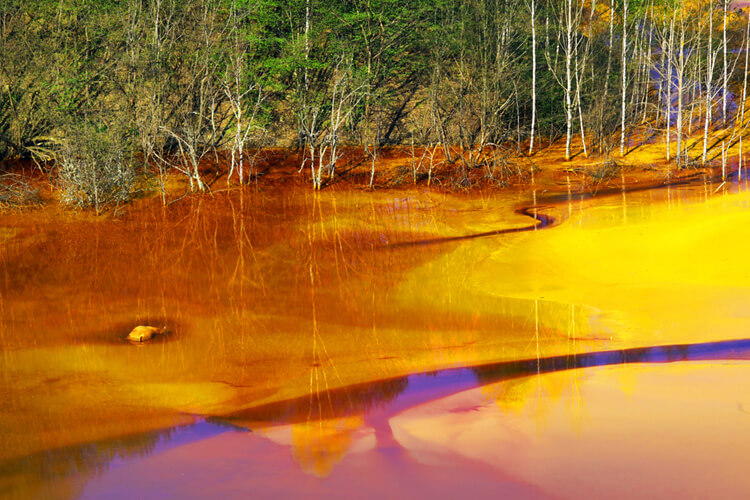
Polymer banknotes are introduced by the Bank of England
Until now, all banknotes in the UK were made from cotton fibre and linen rag. This made them susceptible to dirt and damage – five pound notes in particular, which lasted on average for just one year. In late 2016, a new range of smaller, plastic banknotes enters circulation.* These are produced from a thin, transparent and flexible film made of polypropylene which offers a number of advantages:
• They are resistant to dirt and moisture, so stay cleaner for longer than paper banknotes.
• They are more secure than paper banknotes. They can incorporate advanced security features, making them more difficult to counterfeit. This includes a portion of the film left clear to form a "window" in the design.
• They are more durable. They last at least 2.5 times longer than traditional paper banknotes, so will take longer to become "tatty", improving the quality of banknotes in circulation. They can even survive being put into a washing machine by accident, for example.
In addition, they are more environmentally friendly and, because they last longer are, over time, cheaper than paper banknotes. Being thin and flexible, they fit into wallets and purses as easily as paper banknotes.
Modern polymer banknotes were first issued as currency by Australia in 1988 (coinciding with that country's Bicentenary year). By the early 2010s, around 20 other countries were using them.
US presidential election
The 58th US presidential election is held on Tuesday 8th November 2016. The incumbent president Obama is ineligible to be elected to a third term, due to term limits in the 22nd Amendment to the US Constitution.
Businessman and TV personality Donald Trump is elected as the 45th President and Mike Pence is elected the 48th Vice President, with Trump becoming the oldest man elected president at the age of 70, as well as the first president in history to take office without any prior political or military experience.
The win is considered one of the most shocking upsets in U.S. history, with most news outlets and experts considering a Trump victory unlikely. The result is also highly controversial, due to Hillary Clinton's popular vote lead of three million votes over Trump, who won via the Electoral College.

« 2015 |
⇡ Back to top ⇡ |
2017 » |
If you enjoy our content, please consider sharing it:
References
1 Panama Canal expansion project, Wikipedia:
https://en.wikipedia.org/wiki/Panama_Canal_expansion_project
Accessed 8th November 2014.
2 Dogs in England must be microchipped from 2016, BBC:
http://www.bbc.co.uk/news/uk-21345730
Accessed 6th February 2013.
3 See 2040.
4 The first supercomputer to reach 100 petaflops, Future Timeline Blog:
https://www.futuretimeline.net/blog/2016/06/21.htm
Accessed 22nd June 2016.
5 Juno – Unlocking Jupiter's Mysteries, NASA:
http://www.nasa.gov/mission_pages/juno/main/index.html
Accessed 2nd September 2011.
6 Five hundred meter Aperture Spherical Telescope, Wikipedia:
https://en.wikipedia.org/wiki/Five_hundred_meter_Aperture_Spherical_Telescope
Accessed 13th December 2014.
7 China building world's biggest radio telescope, gizmag:
http://www.gizmag.com/five-hundred-meter-aperture-spherical-radio-telescope/18930/
Accessed 13th December 2014.
8 Mine of the Future – Rio Tinto's Innovation Pathway, Mine Expo [via Wayback Machine]:
https://web.archive.org/web/20140328213456/http://www.minexpo.com/component/docman/doc_view/157-mine-of-the-future-program-rio-tintos-innovation-pathway.html
Accessed 27th July 2013.
9 Automation drives workers out of mining jobs, The North West Star:
http://www.northweststar.com.au/story/1665671/automation-drives-workers-out-of-mining-jobs/
Accessed 27th July 2013.
10 Codelco to complete automation of mining IT systems by 2016, BN Americas:
http://www.bnamericas.com/news/technology/codelco-to-complete-automation-of-mining-it-systems-by-2016
Accessed 27th July 2013.
11 More automation could mean fewer jobs in mining communities, The University of Queensland:
http://www.uq.edu.au/news/index.html?article=26499
Accessed 27th July 2013.
12 "A technical study was carried out by the UN's International Seabed Authority – the body overseeing deep sea mining. It says companies could apply for licences from as soon as 2016."
See Deep sea mining 'gold rush' moves closer, BBC:
http://www.bbc.co.uk/news/science-environment-22546875
Accessed 27th July 2013.
13 Mining the Seafloor with Robots, Robotics Business Review [Archived on Wayback Machine]:
https://web.archive.org/web/20130818173251/http://www.roboticsbusinessreview.com/research/report/mining_the_seafloor_with_robots
Accessed 27th July 2013.
14 Asteroid mining company reveals plans, Future Timeline Blog:
https://www.futuretimeline.net/blog/2013/01/23.htm
Accessed 27th July 2013.
15 "The technology is ready, and now we can start seeing this penetrating into the market," said Yael Edan, an engineer and robotics researcher at Ben-Gurion University of the Negev in Israel. "I would say there will definitely be robots out there in five years."
See Robots on the Farm, Discovery News:
http://news.discovery.com/tech/robots-farming-agriculture-110412.html
Accessed 4th September 2011.
16 Orange Harvesting, Vision Robotics Corporation [via Wayback Machine]:
https://web.archive.org/web/20111002104414/http://visionrobotics.com/vrc/index.php?option=com_zoom&Itemid=1&catid=4
Accessed 4th September 2011.
17 Hands Free Farm, Agri-EPI Centre:
https://agri-epicentre.com/impact/hands-free-farm/
Accessed 15th January 2024.
18 Hi-def CCTV technology threatens our democracy – we must act now, The Guardian:
http://www.guardian.co.uk/commentisfree/2012/oct/03/high-definition-cctv-threatens-democracy
Accessed 3rd October 2012.
19 High-def CCTV cameras risk backlash, warns UK watchdog, BBC:
http://www.bbc.co.uk/news/technology-19812385
Accessed 3rd October 2012.
20 "...I have been researching this very closely for several
years and have some contacts working for the likes of Samsung in Asia
who develop this. I can assure you that the cost hurdles are mainly related
to research costs and the costs of developing efficient factories and
processes. Billions upon billions of dollars are currently being invested
by LG and Samsung so that they can ramp up production efficiency. The
actual technology should be ready for primetime over the next few years
– starting with some premium ~30" TVs later this year. Commercial
viability, if everything stays on track, should be expected by 2015-16.
Thus LCD technology will likely be phased out over the coming decade,
as I said." -- PCM2, Overclockers.co.uk.
Accessed 5th June 2011.
21 "LG is prepared to ramp up quickly to take the lead in the OLED segment that is expected to reach 7.2 million units in 2016, by which time it should be much more affordable."
See LG launches the first next-generation OLED 55" TV, Future Timeline Blog:
https://www.futuretimeline.net/blog/2013/01/3.htm
Accessed 3rd January 2013.
22 Why make babies from three people?, BBC:
http://www.bbc.co.uk/news/health-27682884
Accessed 19th August 2014.
23 See 2053.
24 The World's Most Polluted Places, TIME:
http://www.time.com/time/specials/2007/article/0,28804,1661031_1661028_1661016,00.html
Accessed 4th September 2011.
25 Amazing Pictures, Pollution in China, China Hush:
http://www.chinahush.com/2009/10/21/amazing-pictures-pollution-in-china/
Accessed 4th September 2011.
26 China to impose green tax on heavy polluters, The Guardian:
http://www.guardian.co.uk/world/2011/feb/04/china-green-tax-polluters?CMP=twt_gu
Accessed 4th September 2011.
27 Plastic banknotes ready for 2016, says Bank of England, BBC:
http://www.bbc.co.uk/news/business-24029785
Accessed 10th September 2013.
![[+]](https://www.futuretimeline.net/images/buttons/expand-symbol.gif)






